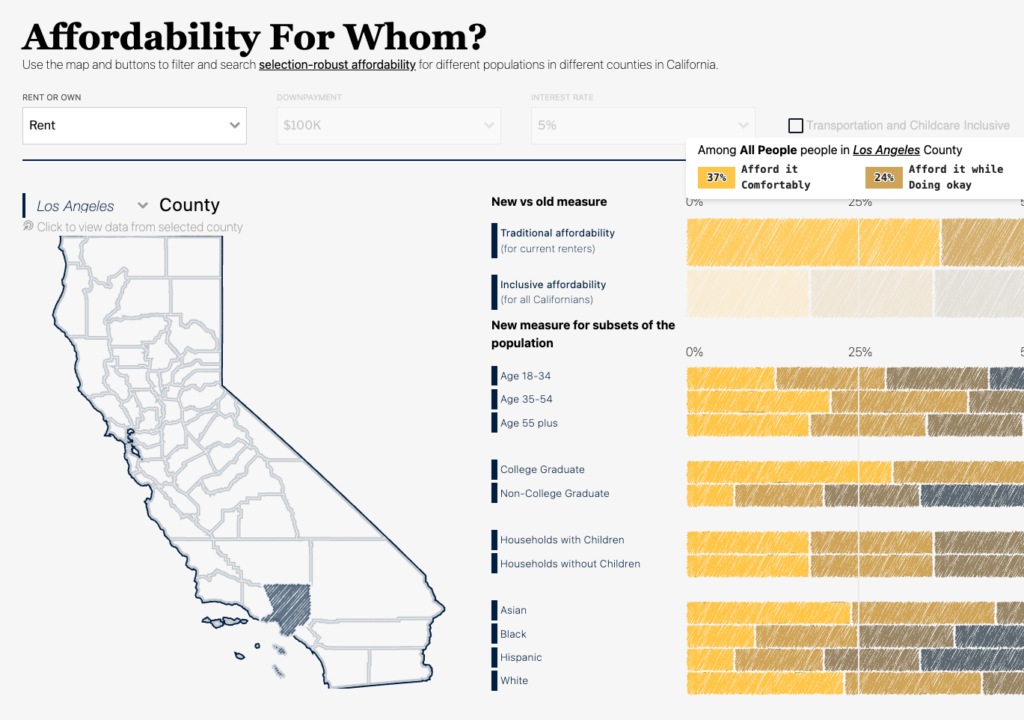The Perils and Promises of Redevelopment: Examining the Use of Tax Increment Financing in California Cities
Published On June 9, 2023
As California cities face a growing backlog of infrastructure needs and a worsening housing affordability crisis, policymakers are looking for additional ways to raise flexible revenue. One popular tool that cities across the U.S. have used for decades to finance development that can generate increased revenues for the city is called tax increment financing (TIF). TIF is a place-based public financing mechanism that allows cities to “capture” increases in assessed property values in a specified area to pay for a portion of the cost of development. TIF is often used to incentivize the building of urban infrastructure or improve public facilities in neighborhoods that a city deems “underdeveloped.”
But like any market-based approach to urban development, TIF comes with challenges, including concerns of private sector enrichment, inadequate community participation, and the physical, social, and cultural displacement of low-income residents. In addition, TIF often only works as one part of a larger strategy for financing infrastructure or development, and it can be difficult to guarantee revenue generation over the long term. This commentary explores the history of TIF in California and identifies several best practices for implementing successful, community-oriented TIF strategies. Recommendations include: championing transparency and data collection, engaging meaningfully with the community in every phase of the project, implementing strong anti-displacement measures, focusing TIF term sheets on existing community needs, and thinking creatively about TIF policy design.
What Is Tax Increment Financing?
Tax increment financing (TIF) is a land value capture mechanism used by cities to generate revenue for development. When a TIF district is established, the “base” value of the development area is set to reflect the current assessed value of properties within the district. This base value remains constant during the entire period of the TIF project, with its property tax revenue continuing to be allocated to the city’s predefined uses. The tax revenue that comes with any increase in property value (or, in some states, sales tax) over the lifetime of the project is separately earmarked for TIF uses, such as the direct construction of infrastructure, reimbursement of capital costs, or debt financing. This increase from the base property tax value and its corresponding revenue is called the tax increment.
The Evolution of TIF in California
California was an early adopter of TIF; the state legislature passed the California Community Redevelopment Act in 1945 to give local government institutions called Redevelopment Agencies (RDAs) the power to administer TIF to address areas of “blight” in cities. By 2008, RDAs were receiving roughly 12 percent of all property tax revenue generated across the state. But as TIF districts expanded, controversy grew. Despite several attempts at reforming TIF law (e.g. Assembly Bill 1290 [1993, Isenberg]), critics like the Municipal Officials for Redevelopment Reform continued to speak out against the lack of public accountability of RDAs. They also claimed that redevelopment projects were draining precious resources from other taxing agencies like school districts, which was putting a strain on state education funding. After the Great Recession in 2008 caused major budget shortfalls for the state, the legislature voted to abolish RDAs in 2012.
But California cities have not fully abandoned TIF—or the redevelopment projects it finances—as an economic development strategy. In 2014, the state brought TIF back to life with the passage of Senate Bill 628 (Beall) for Enhanced Infrastructure Financing Districts (EIFDs). EIFDs are administered directly by local city governments, rather than RDAs. Current EIFD law does not require voter approval for an EIFD to be established, but it does require a city to hold three public hearings, including a protest proceeding. To operate an EIFD, cities must first draft a public-facing infrastructure financing plan that is consistent with the city’s general or specific plan for the district. EIFDs exclude public school districts from diverting any tax increment to a TIF project on a statutory basis. If any other taxing agency (e.g. county government) falls within the project boundaries, it must opt-in before any tax increment revenue is diverted for the development. If any EIFD revenue does go toward housing, it must be affordable housing (although there is no requirement that funds for affordable housing be set aside for EIFDs).
So far, EIFDs have been slow to take off in California, partly because the dissolution of RDAs resulted in a loss of local government capacity to handle the financial and administrative complexities associated with implementing TIF. But there are signs that a growing number of city officials and state legislators are interested in leveraging EIFDs to advance sustainable and equitable urban development goals. Oakland Councilmember Carroll Fife and Mayor Sheng Thao, for instance, have proposed two EIFDs in East and West Oakland that would advance a “Black New Deal” through the “intentional reinvestment into communities impacted by decades of racist policies.” These EIFDs are expected to generate more than $100 million in revenue over ten years to pay for infrastructure, affordable housing, environmental cleanups, and street safety projects in majority-Black neighborhoods.
Making TIF Work for California Communities
State lawmakers are also beginning to think creatively about how EIFDs can benefit communities. California Assemblymember Laura Friedman proposed AB 930 in February 2023 for the “Reinvestment in Infrastructure for a Sustainable and Equitable California (RISE) districts.” This bill would expand the use of EIFDs specifically for infill projects that advance “equitable development in location-efficient areas” and would provide revolving loans for RISE projects with money from the state’s greenhouse gas reduction fund. AB 901 on affordable housing financing districts (proposed by Assemblymember Phil Ting earlier this year) would similarly enable TIF to be used specifically for affordable housing construction.
As EIFDs begin to take root in California cities, policymakers have a unique opportunity to restructure a powerful development financing mechanism to better serve communities and avoid the potential harms of gentrification. Making TIF projects work for existing residents requires strong dealmaking—and fewer compromises—on the part of city officials as well as stricter oversight on the part of state legislatures. Building up staff capacity to do this, however, poses a major challenge for effectively implementing and scaling up TIF projects across California.
Incorporating the following best practices can help cities to effectively utilize TIF to generate revenue while promoting inclusive and equitable development:
- Explore alternative financing options. Before adopting TIF, cities should consider more traditional financing tools like general obligation bonds, tax assessment districts, public-private partnerships, infrastructure investment funds, or municipal investment funds. These tools could encourage place-specific real estate development and local economic growth without introducing some of the challenges that come with TIF.
- Prioritize transparency and data collection. Efforts should be made by cities to invest in monitoring, evaluating, and publicizing whether and how TIF is a) working as it should to generate revenue to pay back bonds used for infrastructure development; b) generating any additional revenue that the city can distribute to other areas of the city that need it; and c) impacting the surrounding neighborhood.
- Conduct deep community engagement. Conducting a needs assessment and stakeholder mapping in the community where a TIF project is being proposed can help the city to incorporate community-appropriate benefits into a development agreement or community benefits agreement (CBA) for the project.
- Invest in anti-displacement measures. Cities should avoid compromising when it comes to affordable housing requirements tied to TIF, as this is one of the strongest anti-displacement tools they have to leverage in negotiations with developers. Other anti-displacement measures include strengthening tenant protections and investing in neighborhood-serving organizations.
- Focus plans on community needs. TIF should only be used to pay for the aspects of the development that have a guaranteed public benefit (e.g. public space, affordable housing, public transit, etc.). Beyond that, requiring CBAs to be agreed upon for TIF projects or tying cultural investments like public art or programming into a TIF project’s term sheet can help to guarantee community-serving infrastructure and amenities.
- Experiment with innovative project design. Proposals like the Black New Deal EIFDs in Oakland or AB 930 “RISE” districts provide models for how cities and states might incorporate racial justice and climate resilience goals into TIF projects. Cities could also draw inspiration from non-conventional financing mechanisms like Social Impact Bonds in the design of TIF.
As part of our commitment to the education and professional development of UC Berkeley students, the Terner Center highlights exceptional student work that connects to our mission and research agenda.
Read the full report as well as a complete set of recommendations in: “The Perils and Promises of Redevelopment.” This professional report was submitted in partial satisfaction of the requirements for the degree of Master of City Planning in the Department of City and Regional Planning of the University of California, Berkeley, May 2023. Carolina Reid, Faculty Research Advisor for the Terner Center, and Ben Metcalf, Managing Director for the Terner Center, both served as faculty advisors. The analyses and policy proposals put forth in these projects may not be reflective of the views of the Terner Center.





